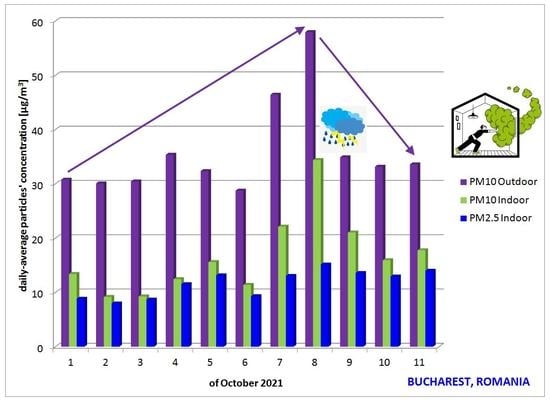Indoor Particle’s Pollution in Bucharest, Romania
Abstract
1. Introduction
2. Materials and Methods
3. Results and Discussions
3.1. Outdoor Particulate Infiltration, PM2.5/PM10 Ratio and Its Rate of Change
3.2. Human Activity Influence on PM2.5/PM10 Ratio and Its Rate of Change
3.3. Indoor Particulate Pollution during the COVID-19 Period and after
4. Conclusions
Author Contributions
Funding
Institutional Review Board Statement
Informed Consent Statement
Acknowledgments
Conflicts of Interest
References
- State of Global Air 2020: A Special Report on Global Exposure to Air Pollution and Its Health Impacts; Health Effects Institute: Boston, MA, USA, 2020.
- Bünger, J.; Krahl, J.; Schröder, O.; Schmidt, L.; Westphal, G.A. Potential hazards associated with combustion of bio-derived versus petroleum-derived diesel fuel. Crit. Rev. Toxicol. 2012, 42, 732–750. [Google Scholar] [CrossRef] [PubMed]
- Sinharay, R.; Gong, J.; Barratt, B.; Ohman-Strickland, P.; Ernst, S.; Kelly, F.J.; Zhang, J.; Collins, P.; Cullinan, P.; Chung, K.F. Respiratory and cardiovascular responses to walking down a traffic-polluted road compared with walking in a traffic-free area in participants aged 60 years and older with chronic lung or heart disease and age-matched healthy controls: A randomised, crossover study. Lancet 2018, 391, 339–349. [Google Scholar] [PubMed]
- Hillman, N.H.; Kallapur, S.G.; Jobe, A.H. Physiology of transition from intrauterine to extrauterine life. Clin. Perinatol. 2012, 39, 769–783. [Google Scholar] [CrossRef] [PubMed]
- Popescu, R.S.; Popescu, L. Assessment of Air Pollution, by the Urban Traffic, in University Campus of Bucharest. J. Environ. Prot. 2017, 8, 884–897. [Google Scholar] [CrossRef][Green Version]
- Ramírez, O.; de la Campa, A.M.S.; Amato, F.; Moreno, T.; Silva, L.F.; Jesús, D. Physicochemical Characterization and Sources of the Thoracic Fraction of Road Dust in a Latin American Megacity. Sci. Total Environ. 2019, 652, 434–446. [Google Scholar] [CrossRef] [PubMed]
- Rojas, J.C.; Sánchez, N.E.; Schneider, I.; Oliveira, M.L.; Teixeira, E.C.; Silva, L.F. Exposure to nanometric pollutants in primary schools: Environmental implications. Urban Clim. 2019, 27, 412–419. [Google Scholar] [CrossRef]
- Silva, L.F.O.; Milanes, C.; Pinto, D.; Ramirez, O.; Lima, B.D. Multiple hazardous elements in nanoparticulate matter from a Caribbean industrialized atmosphere. Chemosphere 2020, 239, 124776. [Google Scholar] [CrossRef]
- Zamberland, D.C.; Halmenschelager, P.T.; Silva, L.F.O.; da Rocha, A.; Rocha, J.B.T. Copper decreases associative learning and memory in Drosophila melanogaster. Sci. Total Environ. 2020, 710, 135306. [Google Scholar] [CrossRef]
- Sly, P.D. Adverse Environmental Exposure and Respiratory Health in Children. Pediatr. Clin. N. Am. 2021, 68, 277–291. [Google Scholar] [CrossRef]
- Zoran, M.A.; Savastru, R.S.; Savastru, D.M.; Tautan, M.N.; Baschir, L.A.; Tenciu, D.V. Exploring the linkage between seasonality of environmental factors and COVID-19 waves in Madrid, Spain. Process Saf. Environ. Prot. 2021, 152, 583–600. [Google Scholar] [CrossRef]
- Catalina, T.; Ghita, S.A.; Popescu, L.L.; Popescu, R. Survey and Measurements of Indoor Environmental Quality in Urban/Rural Schools Located in Romania. Int. J. Environ. Res. Public Health 2022, 19, 10219. [Google Scholar] [CrossRef] [PubMed]
- Mareș, I.C.; Catalina, T.; Istrate, M.A.; Cucoș, A.; Dicu, T.; Burghele, B.D.; Hening, K.; Popescu, L.L.; Popescu, R.S. Research on Best Solution for Improving Indoor Air Quality and Reducing Energy Consumption in a High-Risk Radon Dwelling from Romania. Int. J. Environ. Res. Public Health 2021, 18, 12482. [Google Scholar] [CrossRef] [PubMed]
- Beldean-Galea, M.S.; Dicu, T.; Cucoş, A.; Burghele, B.D.; Catalina, T.; Botoş, M.; Tenter, A.; Szacsvai, K.; Lupulescu, A.; Pap, I.; et al. Evaluation of indoor air pollutants in 100 retrofit residential buildings from Romania during cold season. J. Clean. Prod. 2020, 277, 124098. [Google Scholar] [CrossRef]
- Popescu, L.L.; Popescu, R.S. Indoor air measurements for particle pollution. In Proceedings of the Conference: 2022 8th International Conference on Energy Efficiency and Agricultural Engineering (EE&AE), Ruse, Bulgaria, 30 June–2 July 2022. [Google Scholar] [CrossRef]
- Popescu, L.; Limam, K. Particle Penetration Research Through Buildings Cracks. HVACR Res. 2012, 18, 312–322. [Google Scholar] [CrossRef]
- Popescu, L.L. Influence de la Pollution Exterieure sur la Qualite de l’air Interieur: Role des Fissures dans le Transfert de Particules Solides. Ph.D. Thesis, University of La Rochelle, La Rochelle, France, December 2009. [Google Scholar]
- Szczepanik-Ścisło, N.; Scislo, L. Air leakage modelling and its influence on the air quality inside a garage. E3S Web Conf. 2018, 44, 00172. [Google Scholar] [CrossRef]
- Fine, J.P.; Gray, J.; Tian, X.; Touchie, M.F. An investigation of alternative methods for determining envelope airtightness from suite-based testing in multi-unit residential buildings. Energy Build. 2020, 214, 109845, ISSN 0378-7788. [Google Scholar] [CrossRef]
- Szczepanik-Ścisło, N.; Schnotale, J. CFD simulations and measurements of carbon dioxide transport in a passive house. Refrigeration Science and Technology. In Proceedings of the 24th IIR International Congress of Refrigeration, ICR 2015, Yokohama, Japan, 16–22 August 2015; pp. 4065–4072. [Google Scholar]
- Nirvan, G.; Haghighat, F.; Wang, L.L.; Akbari, H. Contaminant transport through the garage—House interface leakage. Build. Environ. 2012, 56, 176–183. [Google Scholar] [CrossRef]
- Hajji, Y.; Bouteraa, M.; ELCafsi, A.; Belghith, A.; Bournot, P.; Kallel, F. Natural ventilation of hydrogen during a leak in a residential garage. Renew. Sustain. Energy Rev. 2015, 50, 810–818. [Google Scholar] [CrossRef]
- Popescu, R.S.; Popescu, L.L. Outdoor air measurements with mobile laboratory in Bucharest. In Proceedings of the 2022 8th International Conference on Energy Efficiency and Agricultural Engineering (EE&AE), Ruse, Bulgaria, 30 June–2 July 2022. [Google Scholar] [CrossRef]
- Stanek, L.W.; Brown, J.S. Air Pollution: Sources, Regulation, and Health Effects. In Reference Module in Biomedical Sciences; Elsevier: Amsterdam, The Netherlands, 2019; ISBN 9780128012383. [Google Scholar] [CrossRef]
- Kumar, P.; Wiedensohler, A.; Birmili, W.; Quincey, P.; Hallquist, M. Ultrafine Particles Pollution and Measurements. Compr. Anal. Chem. 2016, 73, 369–390. [Google Scholar] [CrossRef]
- de Oliveira Galvao, M.F.; de Oliveira Alves, N.; Ferreira, P.A.; Caumo, S.; de Castro Vasconcellos, P.; Artaxo, P.; de Medeiros, S.R.B. Biomass burning particles in the Brazilian Amazon region: Mutagenic effects of nitro and oxy-PAHs and assessment of health risks. Environ. Pollut. 2018, 233, 960970. [Google Scholar] [CrossRef]
- Chu, B.; Kerminen, V.M.; Bianchi, F.; Yan, C.; Petäjä, T.; Kulmala, M. Atmospheric new particle formation in China. Atmos. Chem. Phys. 2019, 19, 115–138. [Google Scholar] [CrossRef]
- Miller, M.R.; Newby, D.E. Air pollution and cardiovascular disease: Car sick. Cardiovasc. Res. 2020, 116, 279–294. [Google Scholar] [CrossRef] [PubMed]
- Carvalho, H. Air pollution-related deaths in Europe—Time for action. J. Glob. Health 2019, 9, 020308. [Google Scholar] [CrossRef] [PubMed]
- Barthelemy, J.; Sanchez, K.; Miller, M.R.; Khreis, H. New Opportunities to Mitigate the Burden of Disease Caused by Traffic Related Air Pollution: Antioxidant-Rich Diets and Supplements. Int. J. Environ. Res. Public Health 2020, 17, 630. [Google Scholar] [CrossRef]
- Broome, R.A.; Powell, J.; Cope, M.E.; Morgan, G.G. The mortality effect of PM2.5 sources in the Greater Metropolitan Region of Sydney, Australia. Environ. Int. 2020, 137, 105429. [Google Scholar] [CrossRef]
- Forehead, H.; Barthelemy, J.; Arshad, B.; Verstaevel, N.; Price, O.; Perez, P. Traffic exhaust to wildfires: PM2.5 measurements with fixed and portable, low-cost LoRaWAN-connected sensors. PLoS ONE 2020, 15, e0231778. [Google Scholar] [CrossRef]
- Maladie à Coronavirus (COVID-19): Résumé des Hypotheses; Government of Canada: Ottawa, ON, Canada, 2020.
- Kim, K.H.; Kabir, E.; Kabir, S. A review on the human health impact of airborne particulate matter. Environ. Int. 2015, 74, 136–143. [Google Scholar] [CrossRef] [PubMed]
- Schraufnagel, D.E.; Balmes, J.R.; Cowl, C.T.; De Matteis, S.; Jung, S.H.; Mortimer, K.; Perez-Padilla, R.; Mice, M.B.; Riojas-Rodriguez, H.; Sood, A.; et al. Air Pollution and Noncommunicable Diseases: A Review by the Forum of International Respiratory Societies’ Environmental Committee, Part 1: The Damaging Effects of Air Pollution. Chest 2019, 155, 409–416. [Google Scholar] [CrossRef]
- Kwon, H.S.; Ryu, M.H.; Carlsten, C. Ultrafine particles: Unique physicochemical properties relevant to health and disease. Exp. Mol. Med. 2020, 52, 318–328. [Google Scholar] [CrossRef]
- Phairuang, W.; Amin, M.; Hata, M.; Furuuchi, M. Airborne Nanoparticles (PM0.1) in Southeast Asian Cities: A Review. Sustainability 2022, 14, 10074. [Google Scholar] [CrossRef]
- Schraufnagel, D.E. The health effects of ultrafine particles. Exp. Mol. Med. 2020, 52, 311–317. [Google Scholar] [CrossRef] [PubMed]
- Bhatnagar, A. Air Pollution and Cardiovascular Disease. In Braunwald’s Heart Disease: A Textbook of Cardiovascular Medicine; Elsevier: Amsterdam, The Netherlands, 2019; Volume 52, pp. 1032–1037. [Google Scholar]
- Liu, J.Y.; Hsiao, T.C.; Lee, K.Y.; Chuang, H.C.; Cheng, T.J.; Chuang, K.J. Association of ultrafine particles with cardiopulmonary health among adult subjects in the urban areas of northern Taiwan. Sci. Total Environ. 2018, 627, 211–215. [Google Scholar] [CrossRef] [PubMed]
- Rovelli, S.; Cattaneo, A.; Nischkauer, W.; Borghi, F.; Spinazzè, A.; Keller, M.; Campagnplo, D.; Limbeck, A.; Cavallo, D.M. Toxic trace metals in size-segregated fine particulate matter: Mass concentration, respiratory deposition, and risk assessment. Environ. Pollut. 2020, 266, 115242. [Google Scholar] [CrossRef]
- Arias-Pérez, R.D.; Taborda, N.A.; Gómez, D.M.; Narvaez, J.F.; Porras, J.; Hernandez, J.C. Inflammatory effects of particulate matter air pollution. Environ. Sci. Pollut. Res. Int. 2020, 27, 42390–42404. [Google Scholar] [CrossRef]
- Hernandez, M.L.; Peden, D.B. Air Pollution: Indoor and Outdoor. In Middleton’s Allergy: Principles and Practice; Elsevier: Amsterdam, The Netherlands, 2020; Volume 30, pp. 479–499.e1. [Google Scholar]
- Available online: https://www.eea.europa.eu/publications/air-quality-in-europe-2021/air-quality-status-briefing-2021 (accessed on 24 June 2022).
- Khomenko, S.; Cirach, M.; Pereira-Barboza, E.; Mueller, N.; Barrera-Gómez, J.; Rojas-Rueda, D.; de Hoogh, K.; Hoek, G.; Nieuwenhuijsen, M. Premature mortality due to air pollution in European cities: A health impact assessment. Lancet Planet. Health 2021, 5, E121–E134. [Google Scholar] [CrossRef] [PubMed]
- Tanwar, V.; Adelstein, J.M.; Wold, L.E. Double trouble: Combined cardiovascular effects of particulate matter exposure and coronavirus disease. Cardiovasc. Res. 2021, 117, 85–95. [Google Scholar] [CrossRef] [PubMed]
- El Morabet, R. Effects of Outdoor Air Pollution on Human Health. In Reference Module in Earth Systems and Environmental Sciences; Elsevier: Amsterdam, The Netherlands, 2018; ISBN 9780124095489. [Google Scholar] [CrossRef]
- Fattore, E.; Paiano, V.; Borgini, A.; Tittarelli, A.; Bertoldi, M.; Crosignani, P.; Fanelli, R. Human health risk in relation to air quality in two municipalities in an industrialized area of Northern Italy. Environ. Res. 2011, 111, 1321–1327. [Google Scholar] [CrossRef]
- Moreno-Ríos, A.L.; Tejeda-Benítez, L.P.; Bustillo-Lecompte, C.F. Sources, characteristics, toxicity, and control of ultrafine particles: An overview. Geosci. Front. 2022, 13, 101147. [Google Scholar] [CrossRef]
- Xiao, X.; Cao, L.; Wang, R.; Shen, Z.X.; Cao, Y.X. Airborne fine particulate matter alters the expression of endothelin receptors, i.n.rat coronary arteries. Environ. Pollut. 2016, 218, 487–496. [Google Scholar] [CrossRef]
- Soppa, V.J.; Shinnawi, S.; Hennig, F.; Sasse, B.; Hellack, B.; Kaminski, H.; Quass, U.; Schins, R.P.F.; Kuhlbusch, T.A.J.; Hoffmanna, B.; et al. Effects of short-term exposure to fine and ultrafine particles from indoor sources on arterial stiffness—A randomized sham-controlled exposure study. Int. J. Hyg. Environ. Health 2019, 222, 1115–1132. [Google Scholar] [CrossRef]
- Zhai, X.; Mulholland, J.A.; Russell, A.G.; Holmes, H.A. Spatial and temporal source apportionment of PM2.5 in Georgia, 2002 to 2013. Atmos. Environ. 2017, 161, 112–121. [Google Scholar] [CrossRef]
- Munir, S.; Habeebullah, T.M.; Mohammed, A.M.F.; Morsy, E.A.; Rehan, M.; Ali, K. Analysing PM2.5 and its association with PM10 and meteorology in the arid climate of Makkah, Saudi Arabia. Aerosol Air Qual. Res. 2017, 17, 453–464. [Google Scholar] [CrossRef]
- Munir, S. Analysing temporal trends in the ratios of PM2.5/PM10 in the UK. Aerosol Air Qual. Res. 2017, 17, 34–48. [Google Scholar] [CrossRef]
- Zhao, D.; Chen, H.; Yu, E.; Luo, T. PM2.5/PM10 Ratios in Eight Economic Regions and Their Relationship with Meteorology in China. Adv. Meteorol. 2019, 2019, 5295726. [Google Scholar] [CrossRef]
- Pollution Index by City. 2022. Available online: www.numbeo.com (accessed on 21 June 2022).
- Available online: https://www.calitateaer.ro/public/home-page/?__locale=ro (accessed on 14 November 2022).
- Available online: http://www.anpm.ro/documents/12220/2723600/Raport+preliminar+privind+calitatea+aerului+in+Romania_2021.pdf/662d55ac-293f-4e77-8d0f-b2c724b11ceb (accessed on 1 December 2022).
- Available online: https://www.tomtom.com/traffic-index/bucharest-traffic (accessed on 26 September 2022).
- Popescu, R.S.; Istrate, A.; Catalina, T. Impact of Ventilation on the Indoor Particulate Matter Concentrations in a School; Buletinul Institutului Politehnic din IaşI, Romania; Publicat de Universitatea Tehnică, Secţia Construcţii, Arhitectură: Cluj-Napoca, Romania, 2017; Volume 63. [Google Scholar]
- Portable Laser Aerosol Spectrometer. In Model Mini-Las 11-E, Manual for Users; Grimm Aerosol Technik GmbH & Co.KG: Ainring, Germany, 2015.
- Available online: https://legislatie.just.ro/Public/DetaliiDocument/129642 (accessed on 26 September 2022).
- SR EN 16798-1/NA; Energy Performance of Buildings—Ventilation for Buildings—Part 1: Indoor Environmental Input Parameters for Design and Assessment of Energy Performance of Buildings Addressing Indoor Air Quality, Thermal Environment, Lighting and Acoustics—Module M1-6. National Annex: Tokyo, Japan, 2019.
- Boulbair, A.; Benabed, A.; Janssens, B.; Limam, K.; Bosschaerts, W. Numerical study of the human walking-induced fine particles resuspension. Build. Environ. 2022, 216, 109050. [Google Scholar] [CrossRef]
- Available online: https://mindcraftstories.ro/coronavirus/evolutia-covid-19-in-romania/ (accessed on 14 November 2022).
- Available online: https://www.wunderground.com/history/monthly/ro/bucharest/LRBS/date/2021-10-14 (accessed on 14 November 2022).
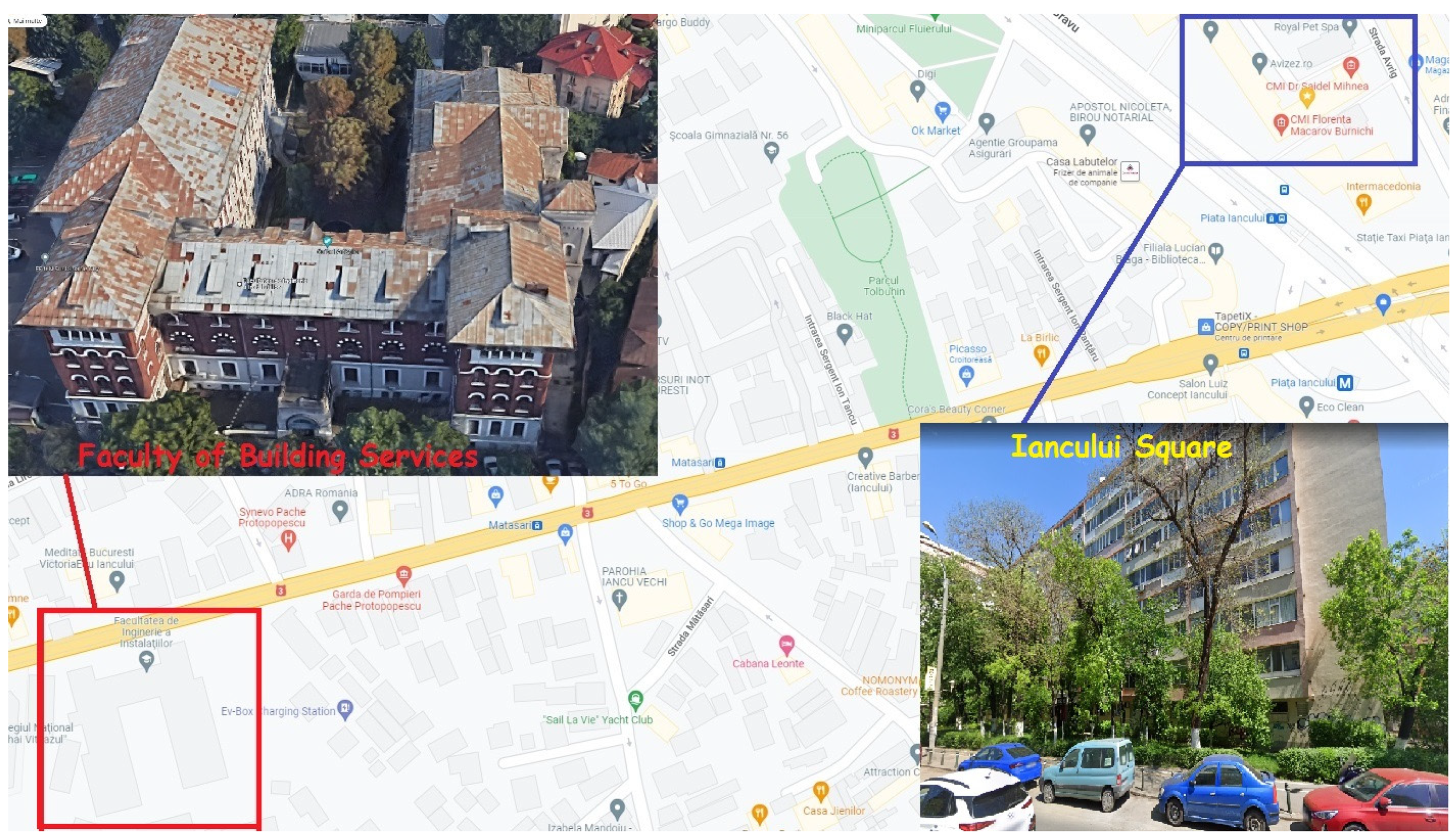



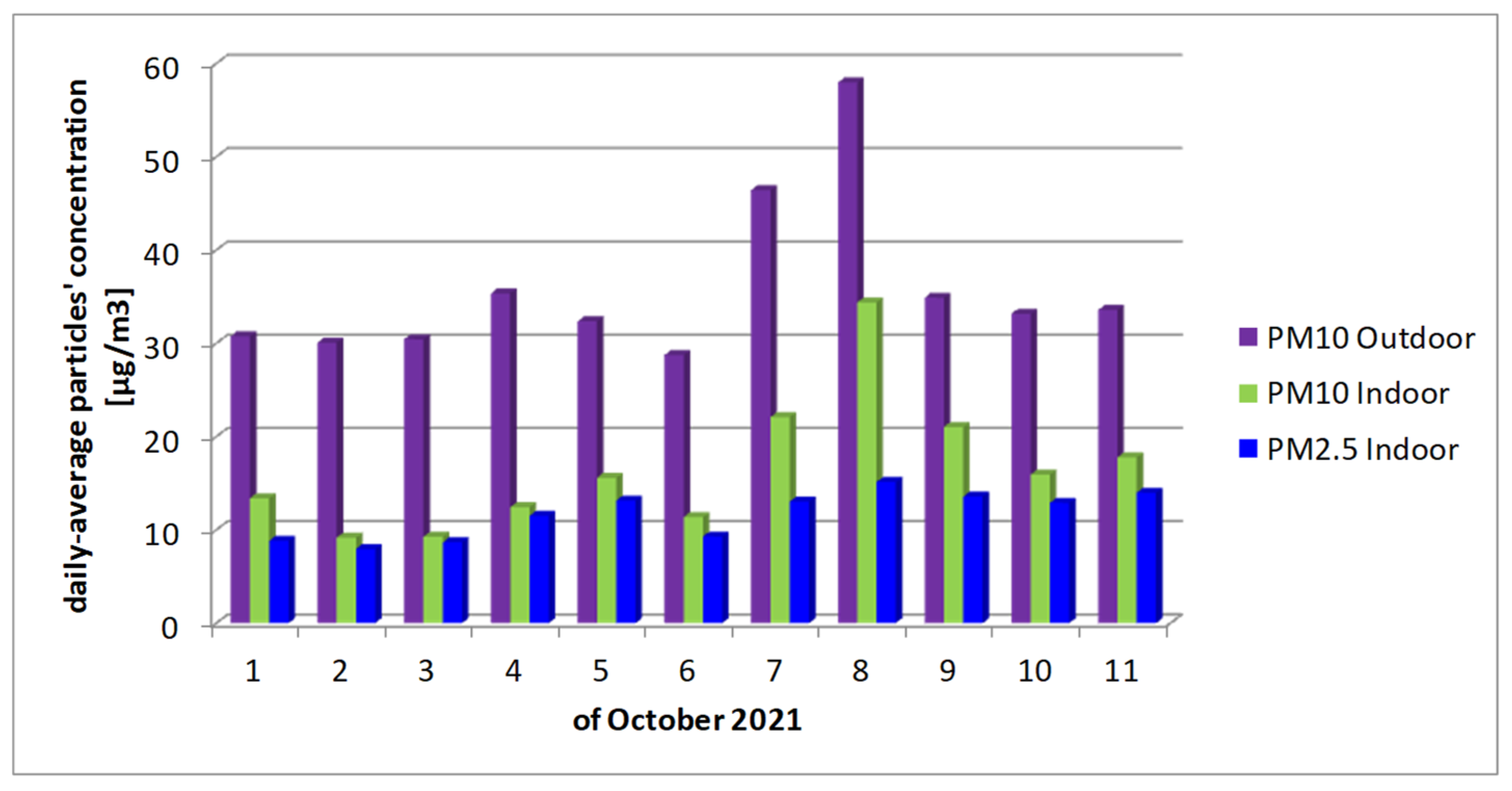
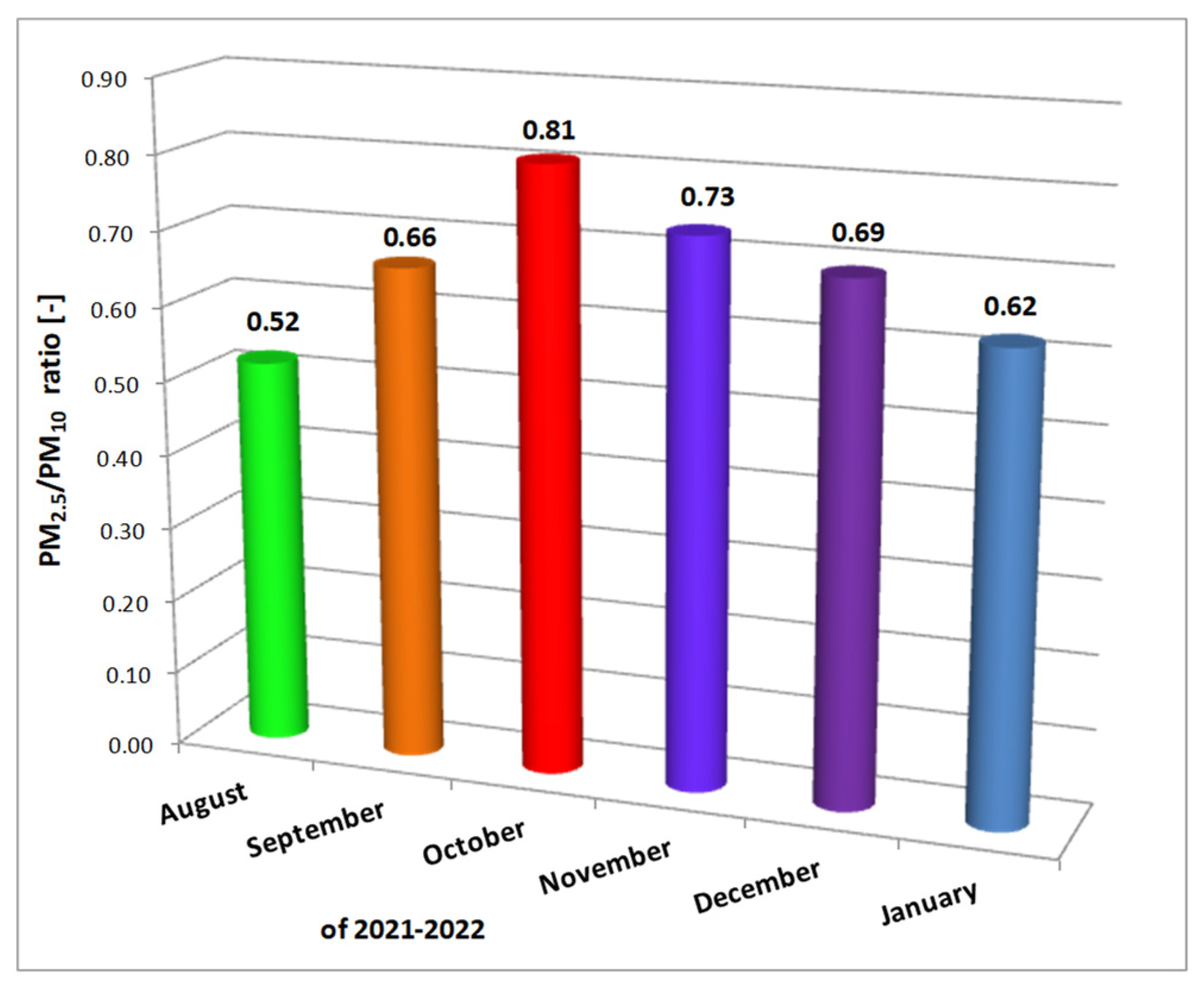
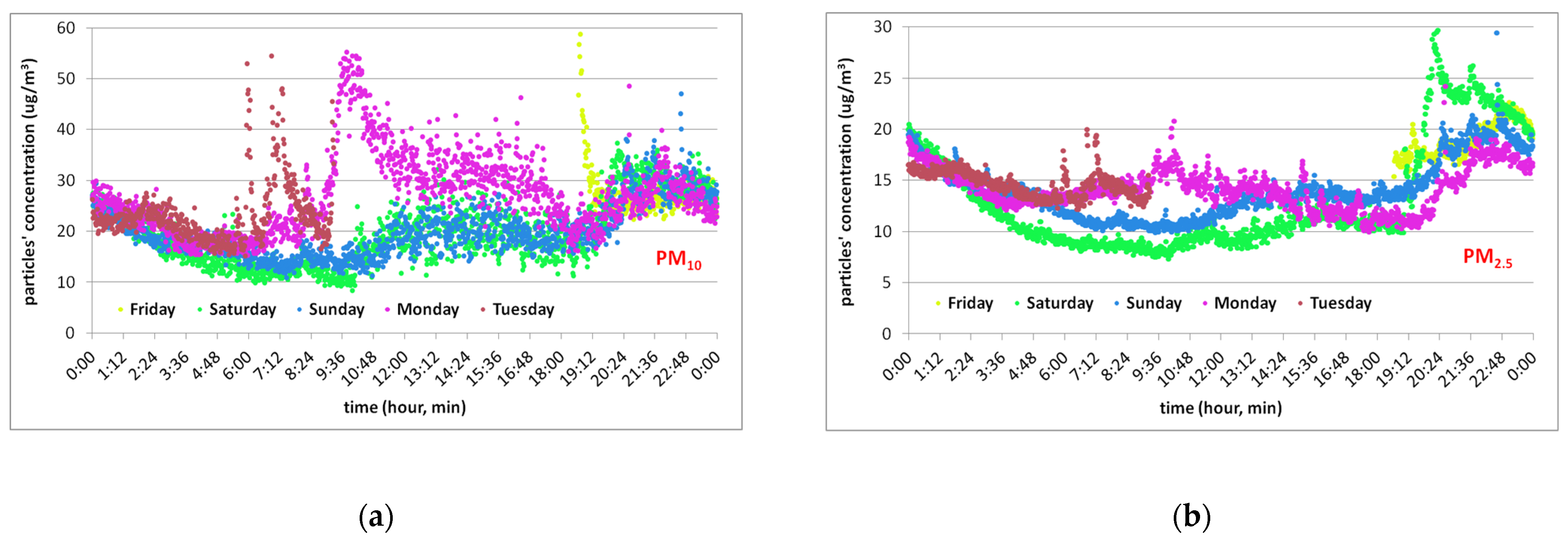


| Measuring Day | Day of the Week | Daily Average Value PM10 [µg/m3] | Daily Average Value PM2.5 [µg/m3] | PM2.5/PM10 Ratio | ROCt |
|---|---|---|---|---|---|
| 1-Oct.-21 | Friday | 13.4 | 8.8 | 0.66 | |
| 2-Oct.-21 | Saturday | 9.2 | 8.0 | 0.87 | 0.32 |
| 3-Oct.-21 | Sunday | 9.3 | 8.7 | 0.94 | 0.08 |
| 4-Oct.-21 | Monday | 12.4 | 11.5 | 0.92 | −0.01 |
| 5-Oct.-21 | Tuesday | 15.6 | 13.1 | 0.84 | −0.09 |
| 6-Oct.-21 | Wednesday | 11.4 | 9.3 | 0.82 | −0.03 |
| 7-Oct.-21 | Thursday | 22.1 | 13.0 | 0.59 | −0.28 |
| 8-Oct.-21 | Friday | 34.4 | 15.1 | 0.44 | −0.25 |
| 9-Oct.-21 | Saturday | 21.0 | 13.6 | 0.65 | 0.47 |
| 10-Oct.-21 | Sunday | 15.9 | 12.9 | 0.81 | 0.26 |
| 11-Oct.-21 | Monday | 17.8 | 14.0 | 0.79 | −0.03 |
| Time Span | PM10 Variation | PM2.5 Variation | ROCt | Week-Day | |
|---|---|---|---|---|---|
| Friday compared to Saturday | 29.1% | 30.3% | Friday | 0.68 | |
| Sunday compared to Saturday | 2.0% | 6.8% | −0.02 | Saturday | 0.67 |
| Monday compared to Sunday | 35.1% | 1.0% | 0.05 | Sunday | 0.70 |
| Tuesday compared to Monday | −12.1% | 3.1% | −0.25 | Monday Tuesday | 0.53 0.62 |
Publisher’s Note: MDPI stays neutral with regard to jurisdictional claims in published maps and institutional affiliations. |
© 2022 by the authors. Licensee MDPI, Basel, Switzerland. This article is an open access article distributed under the terms and conditions of the Creative Commons Attribution (CC BY) license (https://creativecommons.org/licenses/by/4.0/).
Share and Cite
Popescu, L.L.; Popescu, R.S.; Catalina, T. Indoor Particle’s Pollution in Bucharest, Romania. Toxics 2022, 10, 757. https://doi.org/10.3390/toxics10120757
Popescu LL, Popescu RS, Catalina T. Indoor Particle’s Pollution in Bucharest, Romania. Toxics. 2022; 10(12):757. https://doi.org/10.3390/toxics10120757
Chicago/Turabian StylePopescu, Lelia Letitia, Razvan Stefan Popescu, and Tiberiu Catalina. 2022. "Indoor Particle’s Pollution in Bucharest, Romania" Toxics 10, no. 12: 757. https://doi.org/10.3390/toxics10120757
APA StylePopescu, L. L., Popescu, R. S., & Catalina, T. (2022). Indoor Particle’s Pollution in Bucharest, Romania. Toxics, 10(12), 757. https://doi.org/10.3390/toxics10120757






